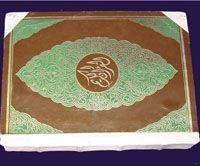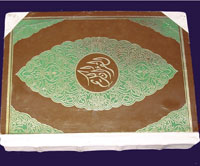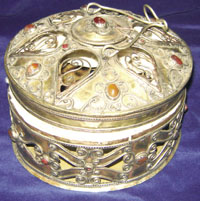
The flourishing of Yemeni handcrafts (Part 1) [Archives:2008/1126/Culture]
February 4 2008
 |
 |
For Yemen Times
Many traditional Yemeni handcrafts are in great demand due to their elegant style and the high quality of raw materials used. However, many more have disappeared completely or are in danger of losing their identity because each craft demands a set of specialized skills and raw materials of high quality. Because Yemen's raw materials are exported outside the country, their prices have increased.
A September 2007 field study attempting to catalog and document traditional handcrafts in the Old City of Sana'a found that while 28 percent the area's residents are craftsmen, most have discontinued such work for several reasons, most importantly, low income and more cheaply imported similar handcrafts.
The national team of the General organization of Antiques and Museum, under the auspice of the social Fund for Development, worked for a year to document all Yemeni handcrafts, which are an important part of the nation's cultural heritage created by various civilizations throughout centuries of history. Thus, they are experiences handed down from generation to generation.
The seven-member research team consisted of: Amat Al-Bari Al-Owadi, Amat Al-Razzaq Jahaf, Abdulqadir Al-Shaibani, Zaid Al-Faqih, Ibrahim Al-Hadid and Abdulaziz Ibrahim.
Team leader Al-Owadi believes that imported handcrafts randomly affected Yemeni handicrafts. According to initial team estimates, Jahaf says only 35 percent of such handcrafts exist today in the Old City, which threatens craftsmen with losing their livelihoods.
Further, because raw materials have become rare, many craftsmen depend on exported raw materials, which affects the quality of the handcrafts.
Flourishing handcrafts
The importance of traditional handcrafts, according to Jahaf, rests in their being exquisitely handmade from local materials and then refined with skill and creativity into unique products.
According to Al-Owadi, only six out of 27 Yemeni handcrafts continue to flourish today. They are: al-hibaka (sewing), al-hizam and al-mahaziq (belts and ribbons), al-asoub (wooden jambiyya sheaths), al-nuhas (copper work), al-mawaqid (fireplace or oven for baking bread) and al-makhabiz (a bakery tool used in an oven or tanoor).
Al-hibaka (sewing)
Although this craft is very ancient, it has flourished in Yemen due to its various uses. For example, al-hibaka preserved important documents and transcripts, as well as being used to wrap al-asoub (jambiyya sheaths).
Jahaf refers to 35-year-old Mohammed Al-Thawr, an Old City craftsman working in this handcraft since he was 11 years old and now specializing in wrapping al-asoub in elegant fabrics.
Mohammed Tahir, 24, recovers books by removing the book's cover, affixing paper and cardboard, followed by a piece of cloth placed over the cardboard. After this, he begins sewing the borders of the book.
Al-hizam and al-mahaziq (belts and ribbons)
The most important material in this handcraft is the leather. Many people buy belts, particularly at the time of the Hajj, choosing them because they are strong and can protect money and important documents.
Working at this craft in the Old City, 75-year-old Ali Al-Haimi explains, “I've done this type of craft since I was 10. At that time in the '60s, there were about 100 leather tanneries, with leather coming to Sana'a from Sa'ada, Taiz, Dhi Sifal and Mahwit.
Specializing in saddles and bridles, Al-Haimi now is the only one making them.
The main problem such craftsmen face is the high price of local leather. “Local leather is high quality, but unfortunately, it's exported outside Yemen, so then we're forced to use imported leather of low quality,” laments craftsman Khalid Safarjal, who now has left such work because it yields a low income.
Al-asoub (jambiyya sheaths)
The plural of al-aseeb, there are different types and forms of al-asoub, according to the particular area and social class. There are two types: the abovementioned aseeb jambiyya and aseeb al-thuma.
With different types, the method and materials used to cover al-asoub vary, but the usual materials are textiles, gold and silver threads, silk threads and leather.
Al-nuhas (copper work)
Based on historical evidence, Yemenis worked at this craft for a long time before the Islamic period. As Jahaf notes, Ibrahim Al-Buraihi's book, “Al-hiraf wa al-sina'at fi dhaw nuqush al-musnad al-janubi” (Handcrafts and Industry in Light of Southern Musnad Inscriptions), mentions that copper and alabaster rings with musnad inscriptions written inside them have been found in Al-Faw village.
Nowadays, the raw materials for copper mostly are used to manufacture arms and weapons and no evidence proves its continued use in making copper handcrafts, which include perfume bottles, lanterns, glasses and pots.
According to Jahaf, Mabruk Al-Yarimi, 29, Bashir Al-Yarimi, 37, and Ayish Al-Yarimi, 33, are the three brothers in the Old City who are considered the most skilled in copper handcrafts and the ones who provide them to merchants, importing the necessary raw materials from India, China and Germany. The brothers learned the craft from their uncles, who supposedly learned it from Jews.
The main problem they face, Jahaf notes, is goods from India, which are cheaper and low quality.
Further, although the three brothers have excelled at the craft, they aren't allowed to put their own stamp upon their goods. As Jahaf explains, “Traders insist on preventing them from stamping their goods by threatening not to buy their goods.
“The rights of these creative brothers aren't preserved because during our research, we found many traders claiming that they made the crafts. However, after a lengthy search, we discovered the truth that the three brothers are the main source for most copper handcrafts,” Jahaf concluded.
Al-mawaqid (fireplaces or ovens for baking bread)
Neither rural nor urban Yemenis can dispense with this handcraft. Bread made in a traditional oven or tanoor is healthier and more delicious, being eaten in both restaurants as well as homes. However, as Jahaf points out, “The traditional ovens we see today aren't the real al-mawaqid because those are no more than 50 years old.”
Al-makhbazat (breadmaking tools)
Al-makhbazat are as important as the tanoor itself. A makhbaza is which bread is made and then baked in a tanoor. “Twenty-five craftsmen work at this craft in the Old City today. Many people, even some tourists, prefer this type of bread to other types,” Jahaf notes.
——
[archive-e:1126-v:15-y:2008-d:2008-02-04-p:culture]


